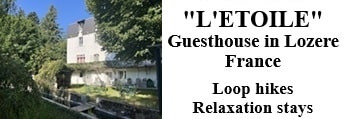History of the city of Mende |
The history of Mende, the prefecture of Lozère, is deeply rooted in time, dating back to Antiquity when it was known as Mimate. Its medieval growth is marked by the influence of the bishop-counts of Gévaudan, who established their seat there and conferred great religious and political importance upon it, materialized by the construction of its cathedral. The city became a dynamic commercial center, notably due to the fairs and markets held there, favored by its strategic position along trade routes. In the 16th century, it suffered the ravages of the Wars of Religion, particularly the siege of 1581 led by the Huguenot captain Merle, which left lasting marks on its architecture. During the Ancien Régime, the city maintained its role as an administrative and judicial center. The French Revolution solidified its status as the capital of the department.

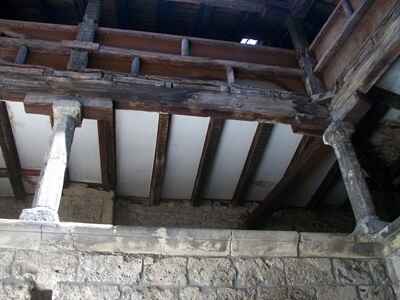 Mende is an ancient city, on the left bank of the Lot, 567 kilometers southeast of Paris, the capital of the Lozère department, an arrondissement, and a district, with a first instance court, a bishopric, a diocesan seminary, a college, a consulting chamber for manufactures, an agricultural society, sciences and arts, etc. It was once the capital of a county, the seat of a bishopric and a bailiwick, depending on the parliament of Toulouse and the generality of Montpellier; it had: a college, seminary, convents of Cordeliers, Carmelites, Capuchins, Ursulines, etc.
Mende is an ancient city, on the left bank of the Lot, 567 kilometers southeast of Paris, the capital of the Lozère department, an arrondissement, and a district, with a first instance court, a bishopric, a diocesan seminary, a college, a consulting chamber for manufactures, an agricultural society, sciences and arts, etc. It was once the capital of a county, the seat of a bishopric and a bailiwick, depending on the parliament of Toulouse and the generality of Montpellier; it had: a college, seminary, convents of Cordeliers, Carmelites, Capuchins, Ursulines, etc.
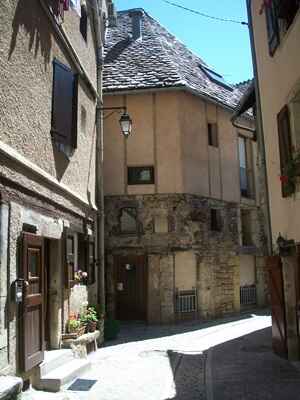 In the 4th century, this city was just a small village (viculus), made up of scattered houses along the left bank of the Lot, below Mount Mimat, which gave it its name, in the midst of a land abundant in dairy products and silver mines. After the destruction of Gabalum and the siege of Grèzes (Castrum Gredonense) by the Vandals (376), Saint Privat, apostle of the Gabales, had taken refuge in a nearby cave on Mount Mimat. Surprised by the barbarians, he refused to sacrifice to their idols. Then, the legend says, they placed the saint in a barrel lined with sharp blades and rolled him down the mountain; but pious souls secretly gathered the body of the martyr and buried it.
In the 4th century, this city was just a small village (viculus), made up of scattered houses along the left bank of the Lot, below Mount Mimat, which gave it its name, in the midst of a land abundant in dairy products and silver mines. After the destruction of Gabalum and the siege of Grèzes (Castrum Gredonense) by the Vandals (376), Saint Privat, apostle of the Gabales, had taken refuge in a nearby cave on Mount Mimat. Surprised by the barbarians, he refused to sacrifice to their idols. Then, the legend says, they placed the saint in a barrel lined with sharp blades and rolled him down the mountain; but pious souls secretly gathered the body of the martyr and buried it.
After the departure of the Vandals, a church was built on his tomb. Soon famous for the miracles performed by his relics, this place, which, according to the chronicler Adon, was just a farm (a hamlet), became populated and covered with houses, and gradually formed a city so considerable that Gabalum was completely abandoned. Mende inherited the power of the ancient city of the Gabales: it became the capital of Gévaudan, and the episcopal seat, which was previously in Javoux, was transferred there. This transfer took place solemnly; the relics of Saint Privat were placed in the church. Since then, the episcopal seat has always remained in this city; it has been suffragan to the archdiocese of Bourges until the establishment of the archbishopric of Albi. Raymond of Saint-Gilles, count of Toulouse and Gévaudan, is said to have ceded his rights over this land to the bishops of Mende.
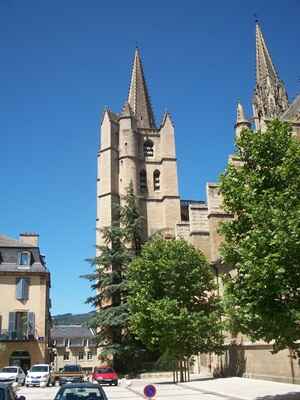 Adalbert, who occupied this seat in 1161, had walls built around Mende, which then became a city. Adalbert having paid homage of his rights to King Louis VII, obtained a golden bull. The king stated in this charter: “That no memory of man has seen any bishop of Gévaudan come to the court of the kings of France, his predecessors, to swear them loyalty, because this land, difficult to access, had always been under the power of the bishops, who exercised temporal and spiritual authority there; that Adalbert, knowing that royal justice belonged to royal authority, had come to acknowledge, in the presence of the principal barons of the kingdom, that his bishopric depended on the crown of France, and that, submitting to the person of the king, he had sworn loyalty to him.” The king “also declares that this act does not prejudice in any way the rights of which the Gabalite bishops had always enjoyed, and he grants to Adalbert and his successors the bishopric of the Gabales, with regal rights. He finally wants that this church be free and exempt from all exaction.”
Adalbert, who occupied this seat in 1161, had walls built around Mende, which then became a city. Adalbert having paid homage of his rights to King Louis VII, obtained a golden bull. The king stated in this charter: “That no memory of man has seen any bishop of Gévaudan come to the court of the kings of France, his predecessors, to swear them loyalty, because this land, difficult to access, had always been under the power of the bishops, who exercised temporal and spiritual authority there; that Adalbert, knowing that royal justice belonged to royal authority, had come to acknowledge, in the presence of the principal barons of the kingdom, that his bishopric depended on the crown of France, and that, submitting to the person of the king, he had sworn loyalty to him.” The king “also declares that this act does not prejudice in any way the rights of which the Gabalite bishops had always enjoyed, and he grants to Adalbert and his successors the bishopric of the Gabales, with regal rights. He finally wants that this church be free and exempt from all exaction.”
Such is the origin of the temporal power that the bishops of Mende enjoyed until the Revolution. They were high justiciaries of the city and had the right to mint coins. They even claimed sovereignty over the land. It is reported that these prelates, officiating pontifically, had a golden scepter placed before them at the altar; one of them, William of Peyre, was not content to wage war against the king of Aragon, but also against his own vassals (1223); these rose up, drove the bishop away, who soon returned, but to resume his intrigues. In 1225, he ceded Gévaudan to James, king of Aragon; his successors still claimed their rights over this land; but already the royalty had grown, and everywhere the feudal lords counted with it. Feeling too weak to resist it, the bishop of Mende consented, in 1306, to share with Philip the Fair the lordship and justice of Gévaudan. According to this treaty, the bishop was recognized as count and the king as sovereign of this land.
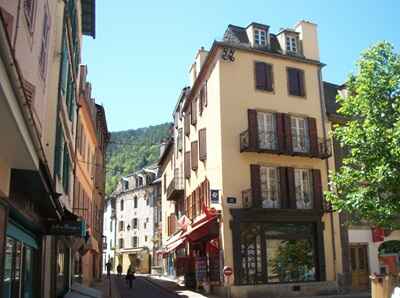 Before 1789, justice was still rendered in their name. When it was the king's turn, it was administered in Marvejols, and in Mende when it was the bishop's turn; the latter also presided over the states of Gévaudan. Among the episcopal seats of France, that of Mende is not the least illustrious: it counts seventy-two bishops, of whom five are saints; one pope, Urban V, and six cardinals.
Before 1789, justice was still rendered in their name. When it was the king's turn, it was administered in Marvejols, and in Mende when it was the bishop's turn; the latter also presided over the states of Gévaudan. Among the episcopal seats of France, that of Mende is not the least illustrious: it counts seventy-two bishops, of whom five are saints; one pope, Urban V, and six cardinals.
In the war of Charles VII and Louis XI against the d'Armagnac, the inhabitants of Mende declared for the monarchy. Thus, Louis XI, to reward his consuls and inhabitants, in 1479, allowed them to add to their arms two lilies at the top of the shield; he did more, he appointed, in 1475, John Petit, bishop of Mende, his lieutenant general in Languedoc, and granted them various privileges. The bishop of Mende, lord of the city, opposed the execution of the king's letters who went beyond and added to the arms he had granted to the consuls and inhabitants of Mende a crowned L between the two lilies that were at the top of the shield (1475).
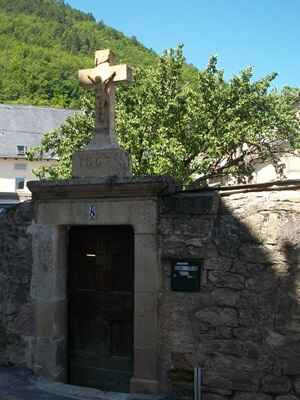 In the 16th century, Mende suffered from the Wars of Religion. Besieged and taken in 1562 by the Protestants, who left only a small garrison, it was retaken by the Catholics when, on Christmas night 1579, while the inhabitants were in the churches, Captain Merle, at the head of a band of Calvinists, scaled the city and captured the main square before the inhabitants could gather. The governor wanted to defend it, but he was killed, and some soldiers who had taken refuge in a tower were forced to surrender. A large number of Catholics were slaughtered, and the city was largely burned and razed. Then the Catholic nobility of Gévaudan, Velay, Auvergne, and Vivarais gathered in Chanac, and under the orders of Saint-Vidal and Christophe d'Apcher, they undertook to drive the religious out of Mende.
In the 16th century, Mende suffered from the Wars of Religion. Besieged and taken in 1562 by the Protestants, who left only a small garrison, it was retaken by the Catholics when, on Christmas night 1579, while the inhabitants were in the churches, Captain Merle, at the head of a band of Calvinists, scaled the city and captured the main square before the inhabitants could gather. The governor wanted to defend it, but he was killed, and some soldiers who had taken refuge in a tower were forced to surrender. A large number of Catholics were slaughtered, and the city was largely burned and razed. Then the Catholic nobility of Gévaudan, Velay, Auvergne, and Vivarais gathered in Chanac, and under the orders of Saint-Vidal and Christophe d'Apcher, they undertook to drive the religious out of Mende.
Saint-Vidal and d'Apcher sent messengers summoning Captain Merle to surrender the place. Merle replied that he was expecting them and that if they did not come to him, he would go to them. He kept his word. Leading a hundred men-at-arms and two hundred mounted arquebusiers, he secretly arrived at Chanac by night, forced the gates, and, seizing the guards, entered the city, from which he only left loaded with loot and taking with him two hundred battle horses taken from the Catholics (1580).
 Châtillon, who commanded in Lower Languedoc for the King of Navarre, persuaded Captain Merle to leave Mende, under the pretense that he needed his assistance for the siege of a place — in reality, to distance him from a city where he compromised the cause of the Reformation by his excesses. Merle fell into the trap; Châtillon took Mende and garrisoned it; but furious at having been played, the Huguenot captain surprised the city, plundered it, and partly expelled the inhabitants who were suspicious of him. Although he later evacuated the place, it was willingly, under a treaty whose terms he dictated (1581). At that time, Mende contained several very rich churches. It is reported that the Calvinists took from Mende more than two hundred eighty marks of silver in sacred vessels and reliquaries. They melted the large bell of the cathedral to make cannons.
Châtillon, who commanded in Lower Languedoc for the King of Navarre, persuaded Captain Merle to leave Mende, under the pretense that he needed his assistance for the siege of a place — in reality, to distance him from a city where he compromised the cause of the Reformation by his excesses. Merle fell into the trap; Châtillon took Mende and garrisoned it; but furious at having been played, the Huguenot captain surprised the city, plundered it, and partly expelled the inhabitants who were suspicious of him. Although he later evacuated the place, it was willingly, under a treaty whose terms he dictated (1581). At that time, Mende contained several very rich churches. It is reported that the Calvinists took from Mende more than two hundred eighty marks of silver in sacred vessels and reliquaries. They melted the large bell of the cathedral to make cannons.
At the end of the 16th century, in 1595, Mende fell into the power of the Duke of Joyeuse. He had a citadel built there, which was razed in 1597, Henri IV having brought the city under his obedience. After its dismantling, the city took no part in the civil or religious wars that broke out in the country under Louis XIII and Louis XIV.
Mende rises in a charming valley on the banks of the Lot, at the foot of mountains from which a great number of springs flow, winding through the gardens and meadows of the scattered bastides around the city. Nothing is more pleasant than the view of these small white houses amidst fertile fields and flourishing orchards. Seen from afar with its triangular shape, its steeples, and its slate roofs, Mende enchants the eyes of the traveler. Its church is quite remarkable. Originally built in the area called the Claustres, due to the cloister that was attached to it, it soon became too small for a numerous clergy and the ever-growing population of the city. It was necessary to think about constructing a larger vessel.
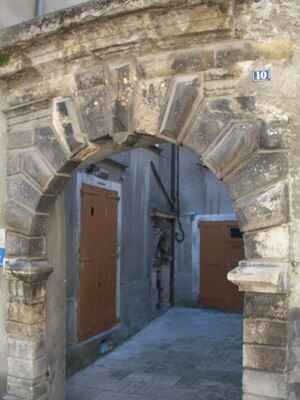 To this end, King Charles V ordered in 1364, at the request of Pope Urban V, who had been bishop of Mende, a census of the fires of Gévaudan, taxed at one florin each; and in 1366, the works began. It was not until 1467 that this reconstruction was completed. In the 16th century, this church was very rich in ornaments, church vessels, chasubles, gold, vermeil, and silver, which it owed to the munificence of Pope Urban V or his bishops; but the Wars of Religion stripped it of these. Restored in 1620, but quite poorly, although its clergy numbered more than a hundred beneficiaries, it is still today a vast and majestic edifice.
To this end, King Charles V ordered in 1364, at the request of Pope Urban V, who had been bishop of Mende, a census of the fires of Gévaudan, taxed at one florin each; and in 1366, the works began. It was not until 1467 that this reconstruction was completed. In the 16th century, this church was very rich in ornaments, church vessels, chasubles, gold, vermeil, and silver, which it owed to the munificence of Pope Urban V or his bishops; but the Wars of Religion stripped it of these. Restored in 1620, but quite poorly, although its clergy numbered more than a hundred beneficiaries, it is still today a vast and majestic edifice.
Built in the Gothic style, it is divided into three naves and topped by two steeples, the highest of which is considered a masterpiece of art. Nothing is more elegant and bolder than its structure, its lacy ornaments, its slender columns, its galleries, and the height of its spire. One must climb two hundred forty-one steps to reach the fourth gallery, where the clock is located. Its spire is octagonal and presents, at the end, interior openings similar to those of minarets.
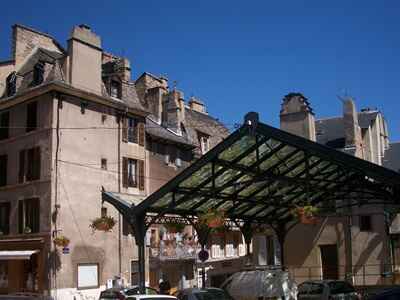 Before the Wars of the 16th century, there was a large bell known as the nonpareille. It was this bell that the Calvinists converted into cannons in 1579. A dome or capital in the shape of an inverted cone, which reportedly represents its dimensions, crowns the spiral staircase tower. After the Hundred Days, the prefect of Lozère and Marshal Soult were imprisoned in this bell tower; but happily, the excesses of the royalist reaction in Mende stopped there.
Before the Wars of the 16th century, there was a large bell known as the nonpareille. It was this bell that the Calvinists converted into cannons in 1579. A dome or capital in the shape of an inverted cone, which reportedly represents its dimensions, crowns the spiral staircase tower. After the Hundred Days, the prefect of Lozère and Marshal Soult were imprisoned in this bell tower; but happily, the excesses of the royalist reaction in Mende stopped there.
There was once in this city a convent of Cordeliers, founded around the year 1220 by Saint Anthony of Padua. Pillaged and sacked by the Huguenots, it was restored by the generosity of the high barons of Gévaudan, whose coats of arms were above the portal of the church and whose tombs were around the forecourt. It appears that these lords, who did not reside in Mende and who had burials in the parish churches of their lands, preferred to be buried in this church.
Several years ago, while clearing it, bones and a ring were found on the bezel of which were engraved arms in a shield. It is believed to have belonged to one of these barons, who, according to custom at the time, being unable to read or write, used his ring to seal his acts, as others did with the pommel of their sword.
Since then, Mende has been tending to beautify itself. Its boulevard and new streets are lined with quite beautiful buildings. Its courthouse, its fountain of the Griffins, its Urban V square where stands the statue of this pope, founder of its cathedral, its city hall, its former episcopal palace, the prefecture, its library, a museum, vast barracks — these are, along with its cathedral, the only remarkable monuments that this city possesses. On the steep and bare slope of Mount Mimat, which overlooks it, lies the hermitage of St. Privat, partly carved into the rock. This hermitage is 200 meters above the city: one ascends by a path where stations for the faithful who go there on pilgrimage rise from time to time.There was a considerable trade in common cloth known as Mende serge, which was shipped to the departments and abroad. A large part of the population derived its livelihood from the products of its factory. The inhabitants of Mende are gentle, affable, and considerate.
This city is the birthplace of the doctor Antoine Blauquet.
The arms of Mende were formerly: azure, with the capital Gothic letter M in silver, with the capital L in gold above, flanked by two golden lilies; they are now: azure, with the capital Gothic letter M in silver (also in gold), and a golden sun at the top. And for a motto: TENEBRE EAM NON COMPREHENDERUNT.
